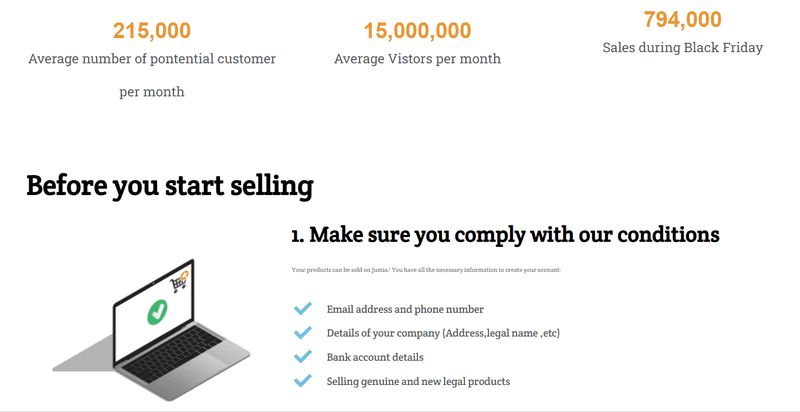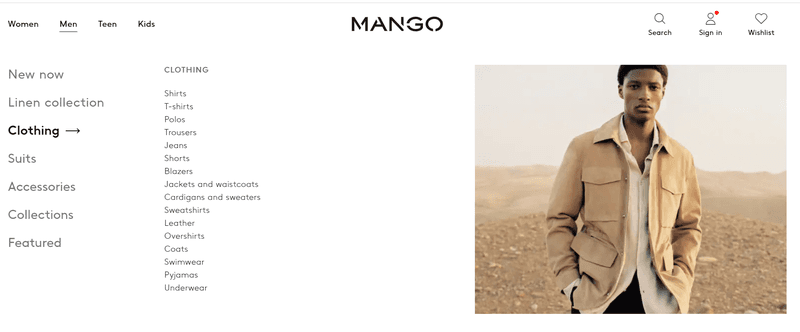How to Sell Clothes Online in Kenya - Quick Guide
Setting up your business online opens doors to a market much larger than your local neighbourhood. Learn how to sell clothes online in Kenya and build a sustainable business.
By 2025, 23% of all sales will be made online. Fashion, specifically clothing, will be a big part of this e-commerce growth.
In emerging markets like Kenya, where traditional commerce has faced challenges due to inadequate infrastructure and a tech-savvy, connected middle class is shifting consumer attitudes, the pace of e-commerce adoption is even faster.
For entrepreneurs looking to get into fashion retail, there is no better place to set up shop than online. The startup capital requirements are lower, margins are better, and the journey to profitability can be much shorter than opening a brick-and-mortar store.
This article will teach you how to sell clothes online in Kenya, including your three most practical options and everything else you need to succeed selling clothes online.
How to sell clothes online in Kenya.
Selling clothes online can be a great way to make money. Selling online requires less startup capital, can be more profitable than operating a brick-and-mortar store, and opens up a larger market well beyond Kenya’s borders.
An online store gives you much more control over your clothing sales business, but it can be overwhelming to run, especially for an entrepreneur who has not run a webstore before.
Thankfully, there are two other ways to sell clothes online besides setting up your own website or online store. These are:
Selling on a third-party platform like Jumia or Kilimall
Using social media to sell your clothes
Each of these three options has its advantages and disadvantages. Let’s look at each of them individually:
1. Selling clothes on online marketplaces
Selling on a marketplace like Jumia or Kilimall is cheaper, faster to set up, and has fewer risks. Because you are setting up on a pre-existing e-commerce platform, all you need to start selling is to set up a seller account and list your products. Of course, there are conditions that you must meet.

To sell on Jumia, for example, a vendor must be a registered business, so you will need to submit your business documents. The products you sell must be legal, genuine, and new, which means your products are reviewed and approved before you can sell.
Besides those conditions, vendors registering on Jumia must provide an email, phone number, and bank account details. You can start selling once your account and product list have been approved.

Jumia will manage the backend processes of managing an online store, including displaying products and accepting payments. It will also manage order fulfilment, although it will let you choose between two options.
You can prepare ordered items, package them and then drop them at Jumia’s delivery centres, ready for shipping. This way, Jumia only takes care of the delivery.
Or you can drop your products in bulk at Jumia’s fulfilment centres and let the platform take care of the entire process; processing, packaging, and delivering ordered items.
Selling on a third-party platform like Jumia is easier, but you'll have to pay fees and have less control over your branding and marketing. But if you sell the right products at the right price, it can be a profitable way to sell online and gives e-commerce beginners a platform to learn before striking out with their own online store.
2. Using social media to sell clothes online.
We have come a long way since the early days of Facebook when it was still a social networking site. Today, it is different things to different people, including a marketing and sales channel.
Not long ago, businesses realised they could build engaged audiences on Facebook to nurture into customers. Now you can practically run your business on Facebook, generating leads and selling your products with your own shop using Facebook Shops and Facebook Page Shops.
Facebook Shops provides a virtual storefront where customers can discover and share your products with their followers.
Facebook also allows shop operators to integrate with e-commerce platforms like Shopify, adding checkout features to their shops and enabling customers to pay for products without leaving Facebook.
Using social media to sell your clothes is a great way to reach a large audience. With Facebook and Instagram, for example, you can access an audience of millions of Kenyans who spend time on the platforms every day.
While building a loyal following and generating sales can be difficult, it is practically free to sell on Facebook. You will do well selling on Facebook if you enjoy creating content, as it is through your content that people will discover and engage with you.
3. Selling clothes through your own online store.

Established businesses with the marketing resources and technical expertise to build a self-hosted website with e-commerce features may prefer to set up an online store than sell on a marketplace or social media.
Setting up your own online store gives you the most control over your business. It gives you full autonomy over pricing, branding, product display, checkout, and order fulfilment, giving complete oversight and control over the customer experience.
Assuming you have your business registration sorted out, starting an online store involves the following steps:
Registered your domain name - this gives you a web address, or where your business will live online,
Set up hosting, which is cloud-based storage where your website files and content will be stored,
Build the website, including choosing the theme and adding all the necessary pages and branding tools,
Connect with the software that will give your website e-commerce functionality so customers can browse products and checkout,
Integrate with a payment gateway to accept customer payments on the website.
All the above steps have separate costs that you must budget for. You will need good quality hosting to prevent downtime when your online store is offline and therefore inaccessible to customers.
You must also engage a skilled and experienced website developer to build an online store that looks good, functions well, and delivers the best shopping experience for your customers.
Regarding the e-commerce platform to use, Shopify and WooCommerce are two of your best options. Shopify will be your best option if you find the above outlined process daunting.
Shopify allows you to set up a fully hosted, functioning online store with only a few steps, but unlike WooCommerce, you have to pay a monthly fee to use it. With WooCommerce, however, you will need to have basic knowledge of how to build and maintain a website.
And whether you choose Shopify or WooCommerce, you will need solid strategies to drive traffic to your product pages. While cost-per-click advertising on Google and on social media works, it can get expensive fast.
A more sustainable marketing channel is SEO, where you optimise your webpages and content around topics people are already searching Google and other search engines for.
If you do it well, SEO guarantees a steady flow of qualified traffic to your online store than ads PPC ads, whose traffic will stop once you exhaust your budget. The traffic you attract through your SEO efforts can also be used to build an email list, which opens a powerful marketing channel that your business owns and fully controls, unlike Facebook followers, whom you can lose at any time.
How to succeed when selling clothes online.
Selling online gives you infinite possibilities, but it is not without pitfalls. It certainly isn’t easy and takes a lot of effort to succeed.
No matter which option you choose, there are a few things you can do to boost sales for your online clothing store:
1. Take high-quality photos of your clothes.
When you sell online, customers cannot physically touch, feel, see, or try the clothes before they buy. They rely on the pictures you show on your product pages. Those pictures have to be detailed and show your clothes in different poses to help the customer visualise how they will look on them.
2. Write clear and concise product descriptions.
Detailed, high-resolution photos of your clothes can only do so much. To truly sell your clothes and give shoppers a sense of what it will feel like to wear them, you have to describe them with words. It is crucial that those descriptions are clear, concise, and persuasive.
3. Offer competitive prices.
While your product photos and descriptions can make your clothes highly desirable, there is a limit to how much shoppers are willing to pay for them. Remember too that you are not the only one selling clothes. So your prices have to match or beat those of your competitors.
4. Provide excellent customer service.
The great thing about fashion is the incredible variety of styles that shoppers can choose from. Still, that is not enough to truly set your online store apart. Shoppers ultimately spend their money where the service and the shopping experience are good.
To build a loyal customer base, you must address customer queries timeously and courteously. You must also ensure a good shopping experience by ensuring every button works and that customers can fill their carts and check out without hitches.
5. Promote your store on social media and other online channels.
The internet is a big place. Customers will not magically land on your website, Facebook Shop, or Jumia store and start filling their carts. You have to promote your business to bring it the attention of potential customers. Content marketing and social media marketing are two reliable channels for promoting your online store.
Other strategies that successful online clothing stores in Kenya are using to reach their target audience and boost sales include:
Offering a wide variety of products
Providing free shipping
Running regular promotions and discounts
Collaborating with influencers
By following the tips and strategies w have discussed above, you can increase your chances of success selling clothes online in Kenya.
How to accept customer payments on your online store
Among the three ways of selling clothes online, opening your own online store gives you the most control over your business, branding, and marketing. But you must get your website infrastructure right, not least the checkout.
If customers struggle to check out because it takes too many steps or they can’t find their payment method of choice, shoppers will get frustrated and abandon their carts. That constitutes lost sales, which can imperil your business if you don’t get it sorted fast.
The payment gateway you choose for your online clothing store is crucial to your success. A payment gateway acts as an intermediary in the payment processing process. It verifies that a customer’s tendered payment method has enough funds to complete the purchase.
Importantly, a payment gateway consolidates different payment methods onto one interface so shoppers can find one they want to use. This boosts the chances of successful sales.
IntaSend is reputed as the best payment gateway for online stores and businesses that wish to accept customer payments on their websites. Whether your webstore runs on Shopify or WooCommerce, the IntaSend Payments plugin is the best way to collect and manage customer payments online in Kenya.
It costs money to attract a customer, so you lose more than the sale itself when one fails to checkout because they cannot not use their preferred payment method. So as well as Mastercard and Visa, the IntaSend payment gateway has added Bitcoin and M-Pesa payment methods to improve your chances of closing every sale.
Sign up with IntaSend and start accepting customer payments on your online clothing store and access tools that help you manage and grow your e-commerce business at the lowest fees in Kenya.

